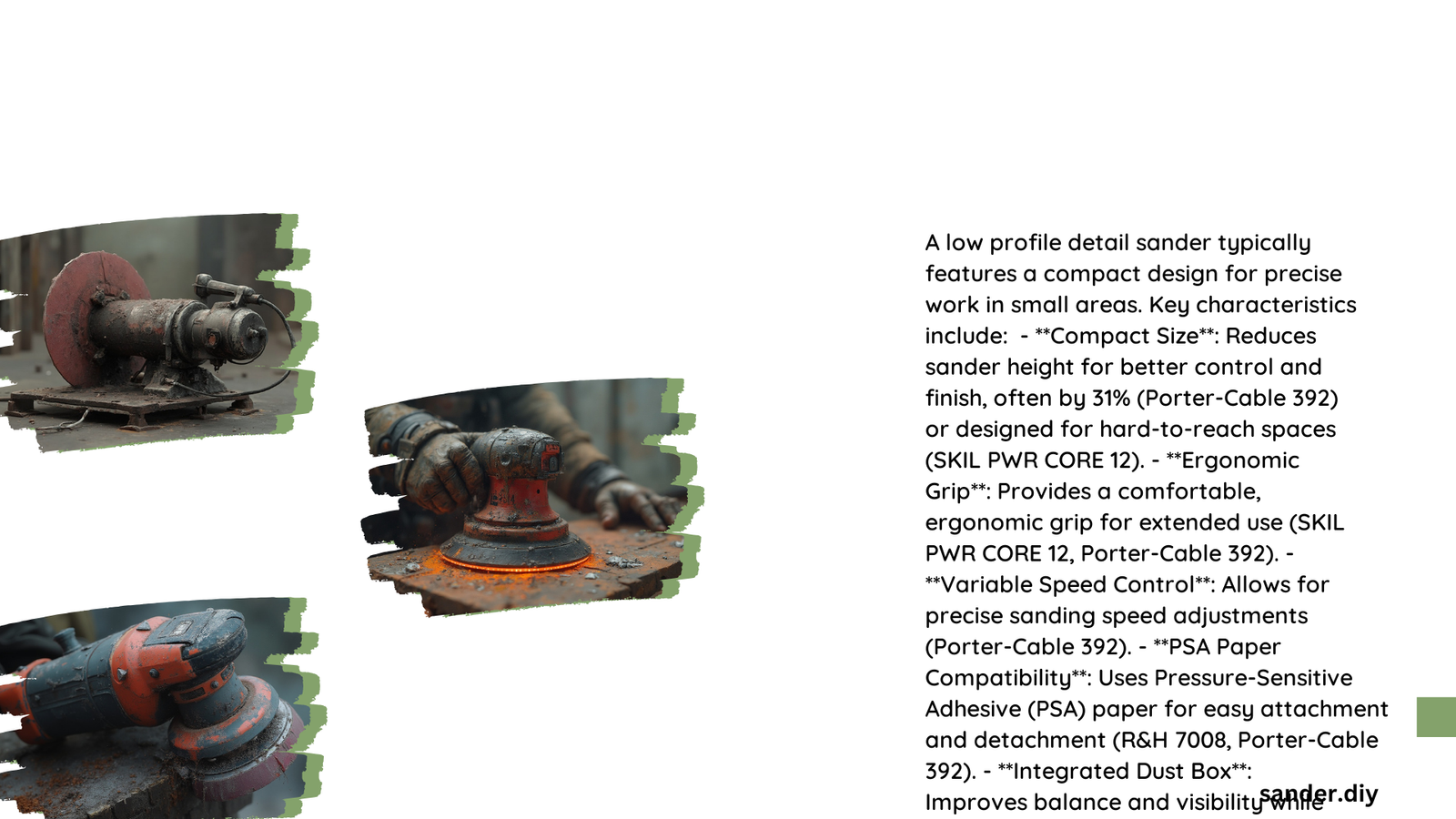Low profile detail sanders are compact, versatile tools designed for precision sanding in tight spaces and intricate areas. These sanders excel at smoothing curved surfaces, corners, and hard-to-reach spots that larger sanders can’t access. With their small size and maneuverability, low profile detail sanders are essential for fine woodworking, furniture restoration, and detailed finishing work. This guide explores the features, applications, and top models of low profile detail sanders to help you choose the right tool for your projects.
What are the Key Features of a Low Profile Detail Sander?
Low profile detail sanders come with several important features that set them apart from other sanding tools:
- Compact Design: Their small size allows for easy maneuvering in tight spaces.
- Triangular or Mouse-Shaped Sanding Pad: Ideal for reaching corners and edges.
- Oscillating or Vibrating Motion: Provides smooth sanding action without leaving swirl marks.
- Dust Collection System: Helps maintain a clean work area and improves visibility.
- Interchangeable Attachments: Allows for versatility in tackling different sanding tasks.
How Does a Low Profile Detail Sander Differ from Other Sanders?

Low profile detail sanders have unique characteristics that distinguish them from random orbital sanders or belt sanders:
- Size: Much smaller and more compact, allowing access to tight spaces.
- Sanding Motion: Uses an oscillating or vibrating motion instead of a circular or linear motion.
- Precision: Designed for detailed work rather than large surface areas.
- Versatility: Can handle intricate shapes and profiles that larger sanders can’t reach.
What are the Best Applications for a Low Profile Detail Sander?
Low profile detail sanders excel in various woodworking and DIY tasks:
- Furniture Restoration: Sanding intricate carvings and mouldings.
- Trim Work: Smoothing baseboards, crown moulding, and window frames.
- Craft Projects: Finishing small wooden objects and detailed artworks.
- Automotive Detailing: Sanding hard-to-reach areas in car interiors.
- Home Renovation: Prepping surfaces in tight corners and along edges.
Which Low Profile Detail Sander Models are Highly Rated?
Several models stand out in the market for their performance and features:
- Bosch GOP40-30C StarlockPlus Oscillating Multi-Tool
- High OPMs (oscillations per minute)
- Low vibration for comfortable use
-
Effective dust collection system
-
Fein MultiMaster FMM 350 QSL
- Powerful motor for aggressive sanding
- Wide range of attachments available
-
Excellent for paint stripping and remodeling tasks
-
BLACK+DECKER Mouse Detail Sander
- Compact and lightweight design
- Affordable option for DIY enthusiasts
-
Decent dust collection capabilities
-
Dremel MM50-01 Multi-Max Oscillating Tool
- Versatile tool with sanding and cutting capabilities
- Quick-change system for easy accessory swaps
- Compact size for detailed work
How to Choose the Right Low Profile Detail Sander?
Consider these factors when selecting a low profile detail sander:
- Power Source: Corded models offer consistent power, while cordless versions provide portability.
- Oscillations Per Minute (OPM): Higher OPM generally means faster sanding.
- Ergonomics: Look for a comfortable grip and balanced design for extended use.
- Dust Collection: Efficient dust collection systems improve work quality and reduce cleanup time.
- Attachments: Consider the variety and availability of compatible attachments.
- Brand Reputation: Established brands often offer better quality and customer support.
What Accessories Enhance Low Profile Detail Sander Performance?
To maximize the utility of your low profile detail sander, consider these accessories:
- Sanding Pads: Various grits for different finishing needs.
- Profile Attachments: For sanding curved and contoured surfaces.
- Dust Collection Bags: Improved dust management for cleaner work.
- Extension Arm: Reaches into deeper recesses and tight spots.
- Foam Backing Pads: Provides cushioning for delicate surfaces.
How to Maintain a Low Profile Detail Sander?
Proper maintenance ensures longevity and optimal performance:
- Clean the sander after each use, removing dust from vents and moving parts.
- Regularly inspect and replace worn sanding pads.
- Check and clean the dust collection system to maintain efficiency.
- Lubricate moving parts as recommended by the manufacturer.
- Store the sander in a dry place to prevent moisture damage.
What Safety Precautions Should Be Taken When Using a Low Profile Detail Sander?
Safety is paramount when operating any power tool. Follow these guidelines:
- Always wear safety glasses to protect your eyes from dust and debris.
- Use a dust mask to avoid inhaling fine particles.
- Ensure proper ventilation in your work area.
- Unplug the sander when changing attachments or performing maintenance.
- Keep hands away from the sanding surface during operation.
- Secure your workpiece to prevent movement while sanding.
How Does a Low Profile Detail Sander Compare to Hand Sanding?
While hand sanding has its place, a low profile detail sander offers several advantages:
| Aspect | Low Profile Detail Sander | Hand Sanding |
|---|---|---|
| Speed | Much faster for most tasks | Slow and labor-intensive |
| Consistency | Provides uniform sanding pressure | Varies with user fatigue |
| Precision | Excellent for intricate work | Good for very delicate areas |
| Effort Required | Less physical strain | Can be tiring for large projects |
| Dust Control | Built-in dust collection | Requires manual cleanup |
Low profile detail sanders significantly reduce the time and effort required for detailed sanding tasks while maintaining a high level of precision.
By understanding the features, applications, and best practices for low profile detail sanders, you can enhance your woodworking and DIY projects with professional-quality results. Whether you’re restoring antique furniture, crafting intricate wooden pieces, or tackling home renovation projects, a low profile detail sander is an invaluable tool in your workshop arsenal.
References:
1. FineWoodworking Forum
2. Bob Vila – The Best Detail Sanders
3. Popular Woodworking – Detail Sanders
